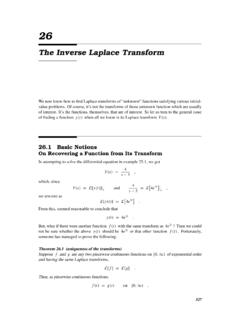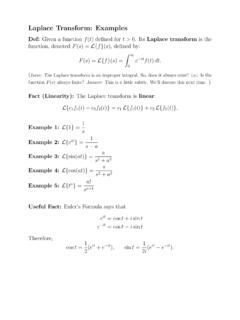Transcription of A Unifled Framework for Numerically Inverting Laplace ...
1 A Unified Framework for Numerically Inverting LaplaceTransformsJoseph Abate900 Hammond Road, Ridgewood, New Jersey 07450-2908, USA,Ward WhittDepartment of Industrial Engineering and Operations Research, Columbia University, New York, NewYork 10027-6699, USA, introduce and investigate a Framework for constructing algorithms to Numerically invertLaplace transforms. Given a Laplace transform fof a complex-valued function of a nonneg-ative real-variable,f, the functionfis approximated by a finite linear combination of thetransform values; , we use the inversion formulaf(t) fn(t) 1tn k=0 k f( kt),0< t < ,where the weights kand nodes kare complex numbers, which depend onn, but do notdepend on the transform for the time argumentt. Many different algorithms can be put intothis Framework , because it remains to specify the weights and nodes.
2 We examine three one-dimensional inversion routines in this Framework : the Gaver-Stehfest algorithm, a versionof the Fourier-series method with Euler summation, and a version of the Talbot algorithm,which is based on deforming the contour in the Bromwich inversion integral. We show thatthese three building blocks can be combined to produce different algorithms for numericallyinverting two-dimensional Laplace transforms, again all depending on the single parametern. We show that it can be advantageous to use different one-dimensional algorithms in theinner and outer words: Laplace transforms, numerical transform inversion, Fourier-series method, Tal-bot s method, Gaver-Stehfest algorithm, multi-precision computing, multidimensional Laplacetransforms, multidimensional transform inversionHistory:Accepted by1.
3 IntroductionIn recent years, numerical transform inversion has become recognized as an importanttechnique in operations research, notably for calculating probability distributions in stochas-1tic models. There have now been many applications; , see the survey by Abate et al.(1999) and the textbook treatment by Kao (1997).Over the years, many different algorithms have been proposed for Numerically invertingLaplace transforms; , see the surveys in Abate and Whitt (1992) and Chapter 19 of Davies(2002), the extensive bibliography of Valko and Vojta (2001) and the numerical comparisonsby Davies and Martin (1979), Narayanan and Beskos (1982) and Duffy (1993). In contrastto the usual approach, in this paper we do not focus on a particular procedure, but insteadintroduce and investigate aframeworkthat can encompass a wide range of procedures.
4 Theflexible Framework opens the way to further work, , performing optimization in order tochoose the best set of parameters and thus the best procedure, by various criteria, for variousclasses of flexible Framework for Numerically Inverting one-dimensional Laplace transforms isalso convenient for developing algorithms to invert multi-dimensional Laplace can combine different one-dimensional inversion algorithms to obtain different multi-dimensional inversion algorithms. In particular, given three different one-dimensional in-version algorithms, we directly obtain nine different two-dimensional inversion algorithms,one for each possible combination in the inner and outer loops. These one-dimensional al-gorithms can be combined with hardly any modifications, in some cases with none at , we show that it can be advantageous from the point of view of algorithm effi-ciency to combine two different one-dimensional inversion algorithms in the two-dimensionalinversion Framework for one-dimensional inversion was originally introduced in several shortpapers by Zakian (1969, 1970, 1973), but it does not seem to have received much attention,if any.
5 Moreover, in those papers, Zakian did not mention the advantage of having a flexibleframework, encompassing several different procedures. Indeed, Zakian proposed a specificprocedure, as we will explain in Section 2. The major contribution here, we believe, issuggesting the more general flexible Framework , encompassing several different procedures,and showing how that can be exploited in multidimensional inversion demonstrate the potential of our proposed flexible Framework , we look at three specificwidely used approaches in this Framework , namely, (i) Fourier series expansions with Eulersummation, (ii) combinations of Gaver functionals and (iii) deformation of the contour in theBromwich integral. These methods are well known as theEuler algorithm(the Fourier-seriesmethod with Euler summation), , see Dubner and Abate (1968), Abate and Whitt (1992,21995), Choudhury, Lucantoni and Whitt (1994a), O Cinneide (1997), Section of Davies(2002) and Sakurai (2004); theGaver-Stehfest algorithm; , see Gaver (1966), Stehfest(1970), Section 8 of Abate and Whitt (1992), Section of Davies (2002) and Valko andAbate (2004); andTalbot s method, , see Talbot (1979), Murli and Rizzardi (1990), Evans(1993), Evans and Chung (2000), Section of Davies (2002) and Abate and Valko (2004).
6 Here is the idea: Given a Laplace transform fof a complex-valued functionfof anonnegative real-variable, f(s) 0e stf(t)dt ,(1)the functionfis represented approximately by a finite linear combinations of the transformvalues, viaf(t) fn(t) 1tn k=0 k f( kt), t >0,(2)where thenodes kandweights k( , the interior and exterior scaling constants) arecomplex numbers, which depend onn, but not on the transform for the time assume that the Laplace transform f(s) in (1) is well defined and analytic forRe(s)>0,whereRe(s) is the real part of the complex variables u+iv; ,Re(s) =ufors=u+ivwithi= 1 anduandvreal numbers. The associated imaginary part ofsisIm(s) =v.(We have assumed that the abscissa of convergence is less than or equal to 0, which isnatural for a large class of applications, but that can be generalized.)
7 Indeed, it is withoutloss of generality, because we can make a change of variables.)Clearly, there are advantages to having thenodes kandweights kin the representationoffn(t) in (2) be independent of both the transform fand the time argumentt. As aconsequence, the procedure can be efficiently applied to multiple transforms and multipletime points. Of course, in general, the accuracy of the approximation will depend on thetransform fand the time argumentt, but there is the potential for great efficiency. Moreover,the same Framework applies to multiple procedures as well, so that independent accuracychecks are readily available most applications,fwill be real-valued; then we approximate by the real part, ,Re{f(t)} Re{fn(t)} 1tn k=0Re{ k f( kt)}=1tn k=0[Re{ k}Re{ f( kt)} Im{ k}Im{ f( kt)}].
8 (3)The case of complex-valued functions arises naturally when we consider inner loops in theinversion of multidimensional transforms; see Section any givenn, and any given set of approximating parameters{ k, k,1 k n}, thefunctionfnon the right in (2) serves as an approximation of the functionf, which we intendto apply for alltthat are continuity points offwith 0< t < . It is understood that theremay be numerical difficulties iftis either very small or very large. In those exceptional casesit is often preferable to apply asymptotics ast 0 ort , , from the initial-valueand final-value theorems (Doetsch 1974); , as in Abate and Whitt (1997). Alternatively,it may be desirable to scale the function, as in Choudhury and Whitt (1997).For any specifict, we can increasenin order to obtain better accuracy.
9 However, greatersystem precision will typically be required to perform the calculation asnincreases. As inAbate and Valko (2004), we suggest exploiting multi-precision software, which is now widelyavailable through computer algebra systems such asMathematicaandMaplein order toobtain the required precision; , see Graf (2004). Such high precision is also an integralpart ofUBASIC, which the second author has been using for more than twenty fact, in this paper weassumethat multi-precision software is being used, so we donot consider special measures to control roundoff error within limited precision ( , stan-dard double precision). The Framework may also be useful with limited precision, providedappropriate measures are taken to control roundoff error, but some procedures, such as theGaver-Stehfest algorithm, usually require high one of the specific inversion routines we consider here (the Euler algorithm), therequired precision as a function ofnwas identified on p.
10 272 of Abate, Choudhury andWhitt (1999). For the other two specific inversion routines we consider here, Abate andValko (2004) identified the required precision as a function ofnfor a large class of transforms.(The full story is rather complicated; see Abate and Valko (2004) for more details.) Thus inour implementations of the three basic methods we obtain automatic algorithms : Giventhe accuracy we want forf(t) (by which we mean relative accuracy, measured in significantdigits; the number of significant digits is defined as log10(relative error); see (34)), aformula specifies the appropriate parametern; then, givenn, the program determines therequired precision for the computation, using another formula, so that the desired accuracyforf(t) is realized.



















